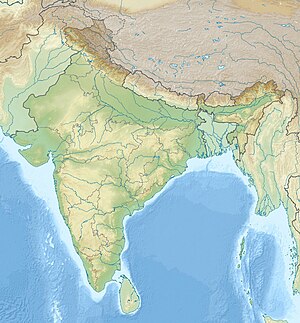Yavanarajya inscription
| Yavanarajya inscription | |
|---|---|
Mathura Museum, India | |
The Yavanarajya inscription, also called the Maghera Well Stone Inscription,
The inscription was published and analysed by French
Inscription
The Yavanarajya inscription is in
Date
The year 116 probably refers to the
Harry Falk and others have suggested that the Yavana era actually started in 174 BCE, based on a reevaluation of the Azes era which is now thought to have started in 47/46 BCE. This reevaluation of the start of the Yavana era means that the Yavanarajya inscription dates to 58 BCE.[10]
Content
The Yavanarajya inscription, written in elegant Sanskrit, reads:[11]
| Translation (English) |
Transliteration (original Brahmi script) |
Inscription (Sanskrit in the Brahmi script) |
|---|---|---|
|
|
 |
Interpretation

The Yavanarajya inscription, states Sonya Rhie Quintanilla, mentions year 116 of the yavana hegemony (yavanarajya), attesting to the 2nd-century and 1st-century BCE Indo-Greek presence. This makes the inscription unique in that it mentions the Indo-Greeks, and it "may confirm" the numismatic and literary evidence which suggests that Mathura was under the ruler of the Indo-Greeks during the period between 185 BCE-85 BCE.[12] It is unclear whether the Indo-Greeks were still present at the time the inscription was engraved, states Quintanilla. She states that the inscription's mention of a family of "Brahmin merchants" is significant as well and the foreign rule must have had a lasting impression on them.[5]
Quintanilla states that the nearly contemporaneous coinage of Menander I (165-135 BCE) and his successors found in the Mathura region, in combination with this inscription, suggests the hypothesis that there was a tributary style relationship between the Indo-Greek suzerains and the Mitra dynasty that ruled that region at the time.[5]
References
- ^ Gerhard Lüdtke; et al. (2009). Kurschners Deutscher Gelehrten-Kalender 2009, Vols 1-4. W. de Gruyter. p. 2766.
- ISBN 9788181520012.
- ^ a b c d e f History of Early Stone Sculpture at Mathura: Ca. 150 BCE - 100 CE, Sonya Rhie Quintanilla, BRILL, 2007 pp. 254-255
- ^ "Some Newly Discovered Inscriptions from Mathura : The Meghera Well Stone Inscription of Yavanarajya Year 160 Recently a stone inscription was acquired in the Government Museum, Mathura." India's ancient past, Shankar Goyal Book Enclave, 2004, p.189
- ^ a b c d History of Early Stone Sculpture at Mathura: Ca. 150 BCE - 100 CE, Sonya Rhie Quintanilla, BRILL, 2007, p.8-10 [1]
- ^ "Ménandre l’Indo-grec ou Paul Demiéville revisité" Journal Asiatique 1993, 1-2, pages 61–138
- ^ Fussman, Gérard. The riddle of the ancient eras is not yet solved (PDF). p. 242.
- ^ Gérard Fussman (1993), "Ménandre l’Indo-grec ou Paul Demiéville revisité", Journal Asiatique, Volume 281, 1-2, pages 113-114
- ^ a b c d History of Early Stone Sculpture at Mathura: Ca. 150 BCE - 100 CE, Sonya Rhie Quintanilla, BRILL, 2007, p.255-256 [2]
- JSTOR 24049367.
- ^ Published in "L'Indo-Grec Menandre ou Paul Demieville revisite," Journal Asiatique 281 (1993) p.113
- ISBN 9789004155374.


